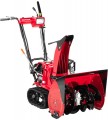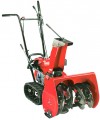Min. throw distance
The shortest distance that the snow blower can throw the collected snow.
The minimum range is indicated only for models with adjustable throw distance (see above). The meaning of this parameter is that in fact, long-range snow casting is not always desirable. For example, when clearing a path in the yard of a private house, snow often has to be poured literally next to the path, a little further — and it will fly onto the windows and walls of the house.
Note that the ejection range is a rather conditional value, because. snow (especially loose, freshly fallen snow) tends to dissipate in flight.
Design
—
Self-propelled design. In self-propelled snow blowers, the built-in motor drives not only the auger, but also the wheels / tracks, ensuring the movement of the device. In this way, you do not have to push the snow blower by hand, which makes work much easier — especially with heavy, powerful models. Most self-propelled models have a transmission that allows you to adjust the speed of movement, as well as the ability to move backward (see "Number of gears").
—
Overload protection. A safety system that protects the unit from breakdowns in the event of critical loads. The main reason for the occurrence of such loads is the jamming of the screw — for example, due to the ingress of a foreign object. Therefore, most often, special bolts are used for protection, connecting the auger to the motor gearbox: with a sharp increase in load, the bolts are cut off and the auger is disconnected from the gearbox. Another option is overheating protection that reacts to engine temperature; it is found predominantly in electrical assemblies and can be used alone or in combination with shear bolts.
—
Headlights. The presence of a headlight (headlights) in the design of the snow blower allows you to use it for work at night, when there are no other light sources or they are not enough. In addition, in some models, the headlights turn on automatically every time the engine is starte
...d — they play the role of a warning signal that the unit is running.
— Heated handles. Heating system for handles, which the operator holds during work. This feature is especially useful as snow blowers are used in cold weather, and hands can get cold during prolonged use. On the other hand, with small volumes of cleaning, you can completely do with gloves, so heated handles are found mainly in powerful models with internal combustion engines, designed for large volumes of work.Max. speed
The maximum speed at which the self-propelled snow blower can travel (see “Design”).
Even in the fastest models, this speed is low — less than 6 km/h, which is comparable to moving at a brisk pace. There are two reasons for this. First, at higher speeds, a walking operator would tyre quickly, if not keep up with the machine at all. Secondly, for snow removal at high speed, very powerful, heavy and voracious engines are required, which it makes no sense to put in "manual" snow blowers.
Starter
The method of starting motor (see "Motor type") of petrol snow blower. Today, the following options are available:
— Manual (starter rope). The simplest way to start: the operator pulls the cable, which turns the shaft and gives the engine the necessary initial impulse. Such starting systems are the most compact, simple and inexpensive, and they do not depend on power sources. On the other hand, it makes sense to use cables mainly in light and low-power snow blowers - to start heavy units, significant force is required, which is easier to provide with an electric starter.
—
Electric starter (230 V mains). Starting with an electric starter powered by a 230 V network (a regular socket). An electric starter is a small electric motor that turns the engine shaft when starting, giving it an initial impulse. Such systems are more complex, heavier and more expensive than cables, but are suitable even for the heaviest and most powerful engines; and the start itself is extremely simple - the user only needs to press a button. At the same time, power from the network allows you to do without heavy and expensive batteries. True, the network itself is required for starting, but this usually does not cause any special problems; and in case the snow blower stalls "in an open field", a backup starting system is usually provided in the form of the same cable. Therefore, most units with electric starters use power from the network.
...
— Electric starter (battery). Starting with an electric starter powered by a battery installed in the snow blower. For general features of electric starters, see above, and battery power makes the starting system as autonomous as possible: the starter can be used regardless of the presence of sockets nearby, and the battery is recharged from the running engine if necessary. On the other hand, the presence of a battery affects the cost and weight of the unit, and the mentioned autonomy is required relatively infrequently. Therefore, electric starters on batteries are used only in certain models of high-performance snow blowers designed for long-term operation "in the field", away from power grids; the weight and price of the battery in such cases are insignificant compared to the weight and price of the unit itself.Fuel consumption
The amount of fuel consumed by the snow blower per hour of operation. From this indicator directly depends on how long the unit is able to work without refueling. Most often, it is a conditional value and in fact it may differ from the claimed figures both in one direction and in the other — depending on the mode of operation, speed, density and thickness of the snow cover, etc.
Noise level
The average noise level produced by the snow blower during operation; the actual volume may differ slightly from this figure, but these deviations are usually negligible.
Note that snow blowers are quite loud equipment, plus the higher the power, the generally higher the noise level. This parameter is measured in decibels, this is a non-linear value, so the actual loudness is easiest to evaluate using comparative tables. So, the most "quiet" modern models give out about 55 – 60 dB — this can be compared with a conversation in slightly raised tones. 70 dB corresponds to a loud conversation, 80 dB to noise on a busy city street, 90 dB to a freight car at a distance of about 7 m, 100 dB to an industrial workshop, 110 dB to a tractor motor at a distance of 1 m.
The lower the noise level, the more comfortable this model will be to use. And according to sanitary standards, the maximum noise level considered safe for prolonged exposure (up to 8 hours) is 80 dB. So if the selected unit is noisier, and you plan to work often and for a long time, you should take care of protective headphones or earplugs.

